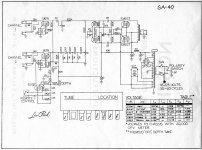Hi there,
Working on a Gibson GA-40 clone - the circuitry part anyway - small chassis.
I'd like to use a dual-concentric switched pot to do the entire tremolo circuit. However, the only one I have available is 250k/500k, whereas I need 500k/500k per the schematic.
My questions are - which would be the better suited spot for the sub of a 250k in place of 500k pot - dwell or frequency?
And, would adding a series resistor pre-250k pot (to reach 500k) be worthwhile or even necessary for the operation of the circuit?
Thanks for your time and insight!
Working on a Gibson GA-40 clone - the circuitry part anyway - small chassis.
I'd like to use a dual-concentric switched pot to do the entire tremolo circuit. However, the only one I have available is 250k/500k, whereas I need 500k/500k per the schematic.
My questions are - which would be the better suited spot for the sub of a 250k in place of 500k pot - dwell or frequency?
And, would adding a series resistor pre-250k pot (to reach 500k) be worthwhile or even necessary for the operation of the circuit?
Thanks for your time and insight!
Attachments
Last edited:
Think about it. The variable resistor in the speed circuit changes the frequency of the oscillation. It is wired as a variable resistor (as opposed to a voltage divider). If you made it 250k instead of 500k, that would be just the same as never turning the 500k past 1/2 way. These are RC circuits so the larger teh resistance, the slower the thiung will oscillate. You make the 500k into 250k, the thing will not have as slow a minimum speed. In my humble estimation, most trems are already too fast. You could probably chyange that 47k wired to it to a 220k or 270k and be back to more or less stock. The control would then lose the top end of the speed range, but then who ever uses the top half of the range anyway?
The depth control is just an amount, so changing that wold probably not hurt you.
The depth control is just an amount, so changing that wold probably not hurt you.
Thanks Enzo - what you said makes perfect sense. Does the depth control resistance store current for the pulse - more resistance/current = more pronounced pulse? Well, I'll experiment with these options and see what results I get.
The 6SQ7 shares a cathode resistor with the second channel tube, so as its current varies, so does the voltage across that cathode resistor, and thus the bias on that tube, and one more thus - so the gain of the tube changes. Voila - tem.
This is an unusual one, the depth pot is adjusting the B+ and plate load to the oscillator stage. That affects how much current flows through the tube, which in turn affects the voltage across that cathode resistor etc etc. and a couple more thusses.
This is an unusual one, the depth pot is adjusting the B+ and plate load to the oscillator stage. That affects how much current flows through the tube, which in turn affects the voltage across that cathode resistor etc etc. and a couple more thusses.
- Status
- Not open for further replies.
